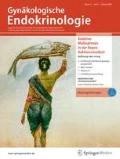Literatur
Donnez J, Tatarchuk TF, Bouchard P et al (2012) PEARL I Study Group. Ulipristal acetate versus placebo for fibroid treatment before surgery. N Engl J Med 366:409–420
Islam MS, Afrin S, Jones SI, Segars J (2020) Selective progesterone receptor modulators-mechanisms and therapeutic utility. Endocr Rev 41(5):bnaa12
Kawaguchi K, Fujii S, Konishi I et al (1991) Immunohistochemical analysis of oestrogen receptors, progesterone receptors and Ki-67 in leiomyoma and myometrium during the menstrual cycle and pregnancy. Virchows Arch A Pathol Anat Histopathol 419:309–315
Bouchard P, Chabbert-Buffet N, Fauser BC (2011) Selective progesterone receptor modulators in reproductive medicine: pharmacology, clinical efficacy and safety. Fertil Steril 96:1175–1189
Tristan M, Orozco LJ, Steed A, Ramirez-Morera A, Stone P (2012) Mifepristone for uterine fibroids. Cochrane Database Syst Rev. https://doi.org/10.1002/14651858.CD007687.pub2
Shen Q, Hua Y, Jiang W, Zhang W, Chen M, Zhu X (2013) Effects of mifepristone on uterine leiomyoma in premenopausal women: a meta-analysis. Fertil Steril 100:1722–1726.e1-10
Williams AR, Critchley HO, Osei J et al (2007) The effects of the selective progesterone receptor modulator asoprisnil on the morphology of uterine tissues after 3 months treatment in patients with symptomatic uterine leiomyomata. Hum Reprod 22:1696–1704
Wilkens J, Chwalisz K, Han C, Walker J, Cameron IT, Ingamells S, Lawrence AC, Lumsden MA, Hapangama D, Williams AR, Critchley HO (2008) Effects of the selective progesterone receptor modulator asoprisnil on uterine artery blood flow, ovarian activity, and clinical symptoms in patients with uterine leiomyomata scheduled for hysterectomy. J Clin Endocrinol Metab 93:4664–4671
Chwalisz K, Larsen L, Mattia-Goldberg C, Edmonds A, Elger W, Winkel CA (2007) A randomized, controlled trial of asoprisnil, a novel selective progesterone receptor modulator, in women with uterine leiomyomata. Fertil Steril 87:1399–1412
ClinicalTrials.gov (2008) Safety of treatment of uterine fibroids with Asoprisnil. https://clinicaltrials.gov/ct2/show/NCT00156208. Zugegriffen: 15. Febr. 2021
Luo X, Yin P, Coon VJ, Cheng YH, Wiehle RD, Bulun SE (2010) The selective progesterone receptor modulator CDB4124 inhibits proliferation and induces apoptosis in uterine leiomyoma cells. Fertil Steril 93:2668–2673
Ioffe OB, Zaino RJ, Mutter GL (2009) Endometrial changes from short-term therapy with CDB-4124, a selective progesterone receptor modulator. Mod Pathol 22:450–459
ClinicalTrials.gov. (2016) A phase 2, study to evaluate the safety and efficacy ProellexR(Telapristone acetate) administered vaginally in the treatment of uterine fibroids. https://clinicaltrials.gov/ct2/show/NCT02323646. Zugegriffen: 15. Febr. 2021
Schutt B, Kaiser A, Schultze-Mosgau MH, Seitz C, Bell D, Koch M, Rohde B (2016) Pharmacodynamics and safety of the novel selective progesterone receptor modulator vilaprisan: a double-blind, randomized, placebo-controlled phase 1 trial in healthy women. Hum Reprod 31:1703–1712
Gemzell-Danielsson K, Heikinheimo O, Zatik J, Poka R, Rechberger T, Hudecek R, Petersdorf K, Ramirez F, Faustmann T, Groettrup-Wolfers E, Seitz C (2020) Efficacy and safety of vilaprisan in women with uterine fibroids: data from the phase 2b randomized controlled trial ASTEROID 2. Eur J Obstet Gynecol Reprod Biol 252:7–14
Blithe DL, Nieman LK, Blye RP, Stratton P, Passaro M (2003) Development of the selective progesterone receptor modulator CDB-2914 for clinical indications. Steroids 68:1013–1017
Levens ED, Potlog-Nahari C, Armstrong AY et al (2008) CDB-2914 for uterine leiomyomata treatment: a randomized controlled trial. Obstet Gynecol 111:1129–1136
Chabbert-Buffet N, Pintiaux-Kairis A, Bouchard P, VA2914 Study Group (2007) Effects of the progesterone receptor modulator VA2914 in a continuous low dose on the hypothalamic-pituitary-ovarian axis and endometrium in normal women: a prospective, randomized, placebo-controlled trial. J Clin Endocrinol Metab 92:3582–3589
Ekanem E, Talaulikar V (2021) Medical therapy for fibroids: what next for ulipristal acetate? Adv Ther 38:137–148
Fernandez H, Schmidt T, Powell M, Costa AP, Arriagada P, Thaler C (2017) Real world data of 1473 patients treated with ulipristal acetate for uterine fibroids: premya study results. Eur J Obstet Gynecol Reprod Biol 208:91–96
Liu JH, Soper D, Lukes A et al (2018) Ulipristal acetate for treatment of uterine leiomyomas: a randomized controlled trial. Obstet Gynecol 132:1241–1251
Simon JA, Catherino W, Segars JH et al (2018) Ulipristal acetate for treatment of symptomatic uterine leiomyomas: a randomized controlled trial. Obstet Gynecol 131:431–439
Kang S, Brinker A, Jones SC, Dimick-Santos L, Avigan MI (2020) An evaluation of postmarketing reports of serious idiosyncratic liver injury associated with Ulipristal acetate for the treatment of uterine fibroids. Drug Saf 43:1267–1276
Ali M, Al-Hendy A (2017) Selective progesterone receptor modulators for fertility preservation in women with symptomatic uterine fibroids. Biol Reprod 97:337–352
Engman M, Granberg S, Williams AR, Meng CX, Lalitkumar PG, Gemzell-Danielsson K (2009) Mifepristone for treatment of uterine leiomyoma. A prospective randomized placebo controlled trial. Hum Reprod 24:1870–1879
Carbonell JL, Acosta R, Pérez Y, Garcés R, Sánchez C, Tomasi G (2013) Treatment of uterine myoma with 2.5 or 5 mg mifepristone daily during 3 months with 9 months posttreatment followup: randomized clinical trial. ISRN Obstet Gynecol 2013:649030
Yerushalmi GM, Gilboa Y, Jakobson-Setton A et al (2014) Vaginal mifepristone for the treatment of symptomatic uterine leiomyomata: an open-label study. Fertil Steril 101:496–500
Stewart EA, Diamond MP, Williams ARW et al (2019) Safety and efficacy of the selective progesterone receptor modulator asoprisnil for heavy menstrual bleeding with uterine fibroids: pooled analysis of two 12-month, placebo-controlled, randomized trials. Hum Reprod 34:623–634
Donnez J, Arriagada P, Marciniak M, Larrey D (2018) Liver safety parameters of ulipristal acetate for the treatment of uterine fibroids: a comprehensive review of the clinical development program. Expert Opin Drug Saf. https://doi.org/10.1080/14740338.2018.1550070
Donnez J, Vázquez F, Tomaszewski J et al (2014) Longterm treatment of uterine fibroids with ulipristal acetate. Fertil Steril 101:1565–1573
Donnez J (2018) Liver injury and ulipristal acetate: an overstated tragedy? Fertil Steril 110:593–595
Author information
Authors and Affiliations
Corresponding author
Ethics declarations
Interessenkonflikt
T. Strowitzki gibt an, dass kein Interessenkonflikt besteht.
Für diesen Beitrag wurden vom Autor keine Studien an Menschen oder Tieren durchgeführt. Für die aufgeführten Studien gelten die jeweils dort angegebenen ethischen Richtlinien.
Additional information
Redaktion
B. Leeners, Zürich
O. Ortmann, Regensburg
C. Tempfer, Herne
Rights and permissions
About this article
Cite this article
Strowitzki, T. Hepatotoxizität selektiver Progesteronrezeptormodulatoren. Gynäkologische Endokrinologie 19, 228–231 (2021). https://doi.org/10.1007/s10304-021-00385-8
Accepted:
Published:
Issue Date:
DOI: https://doi.org/10.1007/s10304-021-00385-8

